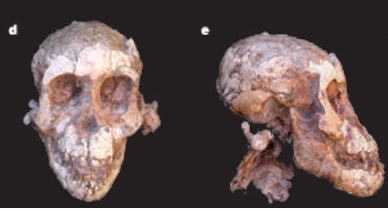Welcome back to EvoAnth v. AiG round 2. If you cast your mind’s eye back a few weeks you’ll recall Answers in Genesis – famous purveyor of all things creationist – decided little ol’ me was worth a ~6,000 word rebuttal. My original response concentrated on the introduction of their piece since I’m rather lazy and not inclined to respond to 6,000 words in a single sitting.
If you recall I wasn’t particularly impressed with their introduction, which seemed more keen on throwing out as many creationist buzz words as possible regardless of whether they were actually applicable to the situation. My favourite was when they claimed one of my points was an assertion (as in, provided without evidence) then went on to dispute the evidence I had provided. Point scoring rather than intellectual honesty was the name of the game.
This post focuses on their response to my claim that the foramen magnum of Australopithecus afarensis is located underneath the skull so it can balance atop a vertical, bipedal body. This is key because our ancestors should look like they’re developing obligate bipedalism, and a foramen magnum would certainly be confirmation of that. AiG disputes this by citing two skulls – AL 444-2 and AL 822-1 – which they claim refutes my central premise. The former skull I discussed in my original post, noting that it has a relatively high “foramen magnum index” which is what one would expect if it were bipedal.

A graph of the location of the foramen magnum and a diagram of its orientation (Australopithecus is the middle image)
Their criticism is that the method used for calculating the foramen magnum index excludes the ape-like jut of the skull’s jaw. However, this is a moot point since the same calculation was used on all the animals included in the FMI comparison. The second is that the aforementioned calculation requires the opisthion (located on the occipital bone), which is missing from the AL 444-2 specimen. What they fail to mention is that we have several examples of Australopithecine occipital bones which can be used to reconstruct AL 444-2, providing the missing data needed for these calculations.
Further, AL 822-1 (the other skull AiG brings up) has the occipital bone, foramen magnum and other aspects of anatomy needed to calculate the FMI. When you do so you get a figure of 23%, compared to the 24% calculated from the reconstruction of AL 444-2.* Not bad at all. This concordance may explain why they try and dismiss AL 822-1, arguing
“That specimen was rebuilt from over 200 fragments. It contains only one small portion of the foramen’s margin on a fragment from the right side…We would submit that the “anterior migration” of the afarensis foramen magnum occurred not deep in the evolutionary history of humanity but quite possibly sometime after 1992 in the laboratory.”
Of course, this is simply a smear campaign. They provide no evidence of any misdoings in the lab; nor anatomical justification for why the reconstruction is suspect. It’s just handwaving talk of “oooo biases” and “oooo incomplete skull” with no real meat to it. Still, it would be nice to have a complete skull to remove any lingering doubts of bias. Boy wouldn’t that really give AiG’s argument a good beatdown. But if such a specimen existed, surely AiG would’ve brought it up because they are intellectually honest. Since they didn’t that must mean it doesn’t exist.

Oh wait…
Alas this is not quite definitive proof of my position since it is the skull of a juvenile; and the foramen magnum can move during development. Nonetheless it is located in a much more human-like position than an ape of comparable age. When this fact is combined with the relatively high FMI of the other skulls (as well as other examples of the foramen magnum not discussed here) I think it’s more than enough evidence for the idea that Australopithecus afarensis had a foramen magnum suited for bipedal locomotion.
*The range of the FMI for Au. afarensis is 19-24%. However, the lowest value is still significantly higher than the value for chimps and the average value (22%) is even more so.

